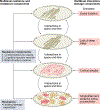A complex systems approach to aging biology
- PMID: 37117782
- PMCID: PMC12007111
- DOI: 10.1038/s43587-022-00252-6
A complex systems approach to aging biology
Abstract
Having made substantial progress understanding molecules, cells, genes and pathways, aging biology research is now moving toward integration of these parts, attempting to understand how their joint dynamics may contribute to aging. Such a shift of perspective requires the adoption of a formal complex systems framework, a transition being facilitated by large-scale data collection and new analytical tools. Here, we provide a theoretical framework to orient researchers around key concepts for this transition, notably emergence, interaction networks and resilience. Drawing on evolutionary theory, network theory and principles of homeostasis, we propose that organismal function is accomplished by the integration of regulatory mechanisms at multiple hierarchical scales, and that the disruption of this ensemble causes the phenotypic and functional manifestations of aging. We present key examples at scales ranging from sub-organismal biology to clinical geriatrics, outlining how this approach can potentially enrich our understanding of aging.
© 2022. Springer Nature America, Inc.
Conflict of interest statement
Competing Interests
AAC is CEO and founder at Oken Health.
Figures





References
-
- Odum EP. The strategy of ecosystem development. Science 1969; 164: 262–270. - PubMed
-
- May RM. Qualitative stability in model ecosystems. Ecology 1973; 54: 638–641.
-
- May RM. Biological populations with nonoverlapping generations: stable points, stable cycles, and chaos. Science 1974; 186: 645–647. - PubMed
-
- May RM. Stability in model ecosystems. The Proceedings of the Ecological Society of Australia 1971; 6: 18–56.
Publication types
MeSH terms
Grants and funding
LinkOut - more resources
Full Text Sources
Other Literature Sources

